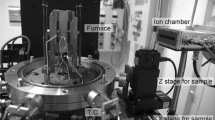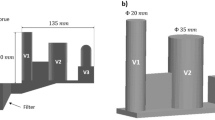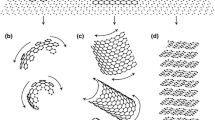Abstract
Cast iron is a eutectic alloy consisting primarily of iron, carbon, and silicon. Depending on the composition and solidification conditions, the carbon can solidify either as cementite or graphite with a variety of morphologies. Because the microstructure directly influences the mechanical properties and the performance of the macroscopic part, a deeper understanding of the solidification behavior of the material is required. In this work, the solidification velocity and composition were independently and systematically varied in a well-controlled environment. Near-eutectic samples with varying amounts of Mg, Ce, and Si were directionally solidified with velocities from 10 to 30 \( \frac{{\mu {\text{m}}}}{{\text{s}}} \) in a Bridgman furnace. White cast iron was used as a starting material, which effectively suppressed flotation of graphite, so that a uniform composition and microstructure along the length of the samples was achieved. A range of morphologies were observed, including spheroidal austenite–graphite colonies, austenite–cementite eutectic, nodular graphite, and two distinct types of austenite dendrites. These structures were qualitatively and quantitatively assessed, and compared with a recently published schema describing the solid/liquid interface behavior of cast iron as a function of cooling rate and nodularizing elements.












Similar content being viewed by others
References
P. Magnin and W. Kurz: Met Trans A, 1988, 19(8), pp. 1955–1963.
K. Herfurth: Freiberg Research Bulletin, 1965, vol. 105, pp. 267–310.
D.D. Double and A. Hellawell: Acta Met Mater, 1995, 43(6), pp. 2435–2442.
D.M. Stefanescu, R. Huff, G. Alonso, P. Larrañaga, E. De la Fuente and R. Suarez: Metall. Mater. Trans. A, 2016, 47(8), pp. 4012–23.
D.M. Stefanescu, G. Alonso, P. Larrañaga, E. De la Fuente and R. Suarez: Acta Mater., 2016, vol. 107, pp. 102–126.
A. Roviglione and J. Hermida: Metall. Mater. Trans. B, 2004, 35(2), pp. 313–30.
D. Shi, D. Li, G. Gao and L. Wang: Mater. Trans., 2008, 49(9), pp. 2163–2165.
M. Górny and E. Tyrała: J. Mater. Eng. Perform., 2013, 22(1), pp. 300–305.
S. Amini and R. Abbaschian: Carbon, 2013, vol. 51, pp. 110–123.
K. Lakeland, H. Hogan, in Recent Research on Cast Iron, ed. by H.D. Merchant (Gordon & Breach Science Publishers Ltd., Detroit, MI, 2017), pp. 417–48
A. Riding and J. Gruzleski, Cast Met Res J, 1971, vol. 7, pp. 67–69.
D. Argo and J. Gruzleski, Mater. Sci. Tech., 1986, vol. 2, pp. 1019–1024.
J.C. Hendrix, D.M. Stefanescu and P.A. Curreri: Am. Foundry Soc. Trans., American Foundry Society, Schaumburg, Ill, 1987, pp. 417–48.
D. Bandyopadhyay, D. Stefanescu, I. Minko, S. Biswal: Physical Metallurgy of Cast Iron IV, Materials Research Society, Pittsburgh, PA, pp. 27–34 (1990)
D. Stefanescu: ASM Handbook, D. Stefanescu (Ed.), ASM, vol. 15, ASM 475 International, Metals Park, Ohio, 1989, pp. 168–81.
J.R. Davis: ASM Specialty Handbook: Cast Irons, ASM International, Metals Park, OH, 1996.
H. Nieswaag, and A. Zuitho: The Metallurgy of Cast Iron, B. Lux, I. Minkof, F. Mollard (Eds.), Georgi Publishing Co., St. Saphorin, Switzerland, 1975, p. 327.
ISO 16112, Compacted (Vermicular) Graphite Cast Irons—Classification, The International Organization for Standardization (Switzerland, Geneva, 2017)
P.D. Merica and L.J. Gurevich: Notes on the graphitization of white cast iron upon annealing, vol. 129, Government Printing Office, Washington D.C., 1919.
ASTM International A247-17, Standard Test Method for Evaluating the Microstructure of Graphite in Iron Castings, West Conshohocken, PA, (2017)
D. Stefanescu, G. Alonso, P. Larrañaga and R. Suarez: Acta Mater., vol. 103, 2016, pp. 103–114.
Acknowledgments
Initial melts were prepared at the UAB Materials Processing and Application Development Center (MPAD) as part of the project DE-EE0005980 through the USA Department of Energy and Caterpillar Inc. Foundry activities occurred under the guidance of John Griffin with support from the entire UAB MSE metal casting group. Additional project support was provided by the National Science Foundation under Grant No. 1554856. The authors thank Dr. Robin Foley for many fruitful discussions.
Author information
Authors and Affiliations
Corresponding author
Additional information
Publisher's Note
Springer Nature remains neutral with regard to jurisdictional claims in published maps and institutional affiliations.
Manuscript submitted September 27, 2018.
Rights and permissions
About this article
Cite this article
Chakraborty, S., Gadkari, S., Steinmetz, P. et al. Evolution of Microstructure in Directionally Solidified Cast Iron Treated with Cerium and Magnesium. Metall Mater Trans A 50, 2922–2932 (2019). https://doi.org/10.1007/s11661-019-05218-9
Received:
Published:
Issue Date:
DOI: https://doi.org/10.1007/s11661-019-05218-9




